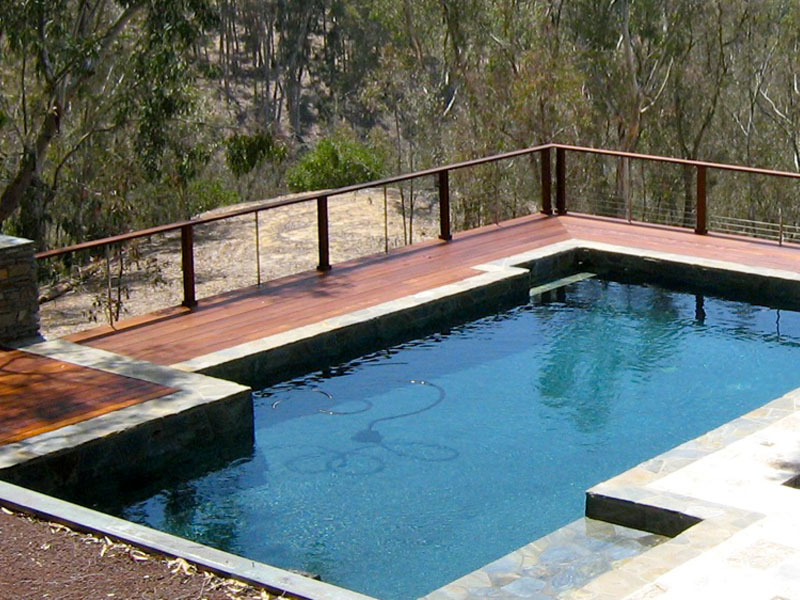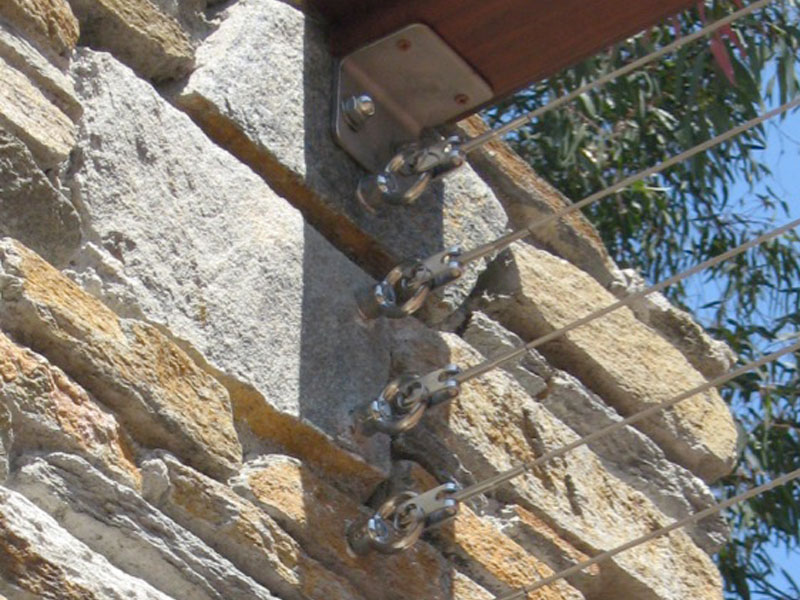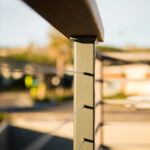Historically speaking, cable railings were initially utilized on boats and docks as guardrails. Wire rope and “rigging” hardware was also commonly found in aviation applications. On a larger scale “barrier rail” systems and post tensioning practices were being pioneered as early as the 1970s and 80s. Because of the versatility and durability of steel cables, the transition to residential cable railing systems was quite natural. Waterfront applications and modern designs were followed by mainstream acceptance. It hasn’t taken long for cable railings to become the most popular railing trend in the remodeling space.

A poolside cable railing system installation from 2007 when hand crimped hardware and marine rigging systems were commonly used for deck railings.
The Most Popular Railing Trend for Over a Decade
Our company history with cable railings dates back to the early 2000s, when “cable railing systems” were few and far between. They weren’t called out by many designers, and most municipalities had no standards for cable railings. Politically driven information about climbing hazards and something called the “ladder effect” slowed the progress of cable railing systems. However little to no information was available. Field data, expert opinions, structural testing and architectural data were hard to find in the early adoption of cable railing systems.
In 2003, much of our business was building decks, and 90 percent of these decks required railings. Picket railings were pretty standard, in fact most building standards even use diagrams containing picket railings. However, the first time we installed a stainless cable railing was the last time we ever installed a picket. As a coastal deck building company, it did not make sense for us any longer. Cable railing was more attractive, stronger, invisible and most of our customers feedback was along the lines of.. “it’s really cool”. Our crew was able to construct cable railings as fast or faster than standard pickets with superior results. Our growing customer base agreed and the demand for cable railings has since exploded.

Marine hardware evolved into architectural applications during the early adoption of cable railing systems.
The Differences Between Wire Rope and Cable Railing
There are drastic differences in wire rope assemblies, rigging hardware and cable railing. Barrier cable applications like those used in parking structures differ greatly in scale and loading requirements. The concepts of these systems are similar; applying tension to wire railing infill . The largest difference for online shoppers to note is the difference between flexible and rigid cable. Additionally, the hardware and frequently used galvanized wire and fittings vs. stainless cable counterparts.
Flexibility and rigidity varies in different cable braids and for cable railings we want to use rigid braid. Rigid cable will stretch less than flexible braid, making it an ideal choice. For example; our most utilized cable strand is 1/8″ T316 stainless steel 1×19 braid. Much of the galvanized wire sold online is 7×7 braid which is much more flexible. 1×19 stainless steel braided cable is considered architectural cable and suitable for architectural use. The thin strands of 1×19 are capable of pull tests exceeding 1800 lbs. per cable.

Today cable railings are widely adopted , code compliant, and found inside high end homes all over the world.
Based on our company history of almost 2 decades of cable railing fabrication and installation practices; the following bullets offer a summarized list of some other important points and further understanding of cable railings and history:
- 1/8″ diameter stainless steel cable is the most popular for residential installation
- buying cable and hardware (posts also) from the same manufacturer is highly recommended (made in the USA)
- cable railings utilize a 3″ clear space between cables to achieve the 4″ spacing standard for guardrails
- wooden framed railings will almost always cost less than steel or aluminum framed railings
- cable railings are nearly transparent
- demand for cable railings inside the home has grown tremendously and they are being used for interior stairways on a large scale
- cable railing is a good choice for DIY systems providing professional results
- cable railings are code compliant when installed to meet building standards
San Diego Cable Railings is a company dedicated to the production and distribution of cable railing systems to contractors and homeowners nationwide. If you have questions about cable railings or interest in a quote for our products please visit the quote request page.




